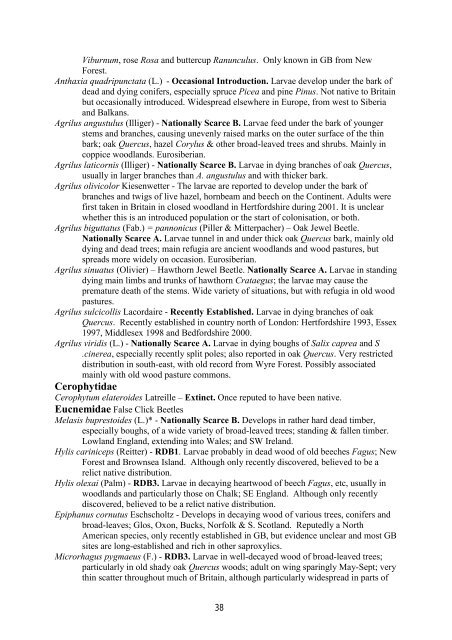Crustacea: Copepoda - Cerambycoidea.com
Crustacea: Copepoda - Cerambycoidea.com
Crustacea: Copepoda - Cerambycoidea.com
Create successful ePaper yourself
Turn your PDF publications into a flip-book with our unique Google optimized e-Paper software.
Viburnum, rose Rosa and buttercup Ranunculus. Only known in GB from New<br />
Forest.<br />
Anthaxia quadripunctata (L.) - Occasional Introduction. Larvae develop under the bark of<br />
dead and dying conifers, especially spruce Picea and pine Pinus. Not native to Britain<br />
but occasionally introduced. Widespread elsewhere in Europe, from west to Siberia<br />
and Balkans.<br />
Agrilus angustulus (Illiger) - Nationally Scarce B. Larvae feed under the bark of younger<br />
stems and branches, causing unevenly raised marks on the outer surface of the thin<br />
bark; oak Quercus, hazel Corylus & other broad-leaved trees and shrubs. Mainly in<br />
coppice woodlands. Eurosiberian.<br />
Agrilus laticornis (Illiger) - Nationally Scarce B. Larvae in dying branches of oak Quercus,<br />
usually in larger branches than A. angustulus and with thicker bark.<br />
Agrilus olivicolor Kiesenwetter - The larvae are reported to develop under the bark of<br />
branches and twigs of live hazel, hornbeam and beech on the Continent. Adults were<br />
first taken in Britain in closed woodland in Hertfordshire during 2001. It is unclear<br />
whether this is an introduced population or the start of colonisation, or both.<br />
Agrilus biguttatus (Fab.) = pannonicus (Piller & Mitterpacher) – Oak Jewel Beetle.<br />
Nationally Scarce A. Larvae tunnel in and under thick oak Quercus bark, mainly old<br />
dying and dead trees; main refugia are ancient woodlands and wood pastures, but<br />
spreads more widely on occasion. Eurosiberian.<br />
Agrilus sinuatus (Olivier) – Hawthorn Jewel Beetle. Nationally Scarce A. Larvae in standing<br />
dying main limbs and trunks of hawthorn Crataegus; the larvae may cause the<br />
premature death of the stems. Wide variety of situations, but with refugia in old wood<br />
pastures.<br />
Agrilus sulcicollis Lacordaire - Recently Established. Larvae in dying branches of oak<br />
Quercus. Recently established in country north of London: Hertfordshire 1993, Essex<br />
1997, Middlesex 1998 and Bedfordshire 2000.<br />
Agrilus viridis (L.) - Nationally Scarce A. Larvae in dying boughs of Salix caprea and S<br />
.cinerea, especially recently split poles; also reported in oak Quercus. Very restricted<br />
distribution in south-east, with old record from Wyre Forest. Possibly associated<br />
mainly with old wood pasture <strong>com</strong>mons.<br />
Cerophytidae<br />
Cerophytum elateroides Latreille – Extinct. Once reputed to have been native.<br />
Eucnemidae False Click Beetles<br />
Melasis buprestoides (L.)* - Nationally Scarce B. Develops in rather hard dead timber,<br />
especially boughs, of a wide variety of broad-leaved trees; standing & fallen timber.<br />
Lowland England, extending into Wales; and SW Ireland.<br />
Hylis cariniceps (Reitter) - RDB1. Larvae probably in dead wood of old beeches Fagus; New<br />
Forest and Brownsea Island. Although only recently discovered, believed to be a<br />
relict native distribution.<br />
Hylis olexai (Palm) - RDB3. Larvae in decaying heartwood of beech Fagus, etc, usually in<br />
woodlands and particularly those on Chalk; SE England. Although only recently<br />
discovered, believed to be a relict native distribution.<br />
Epiphanus cornutus Eschscholtz - Develops in decaying wood of various trees, conifers and<br />
broad-leaves; Glos, Oxon, Bucks, Norfolk & S. Scotland. Reputedly a North<br />
American species, only recently established in GB, but evidence unclear and most GB<br />
sites are long-established and rich in other saproxylics.<br />
Microrhagus pygmaeus (F.) - RDB3. Larvae in well-decayed wood of broad-leaved trees;<br />
particularly in old shady oak Quercus woods; adult on wing sparingly May-Sept; very<br />
thin scatter throughout much of Britain, although particularly widespread in parts of<br />
38

















